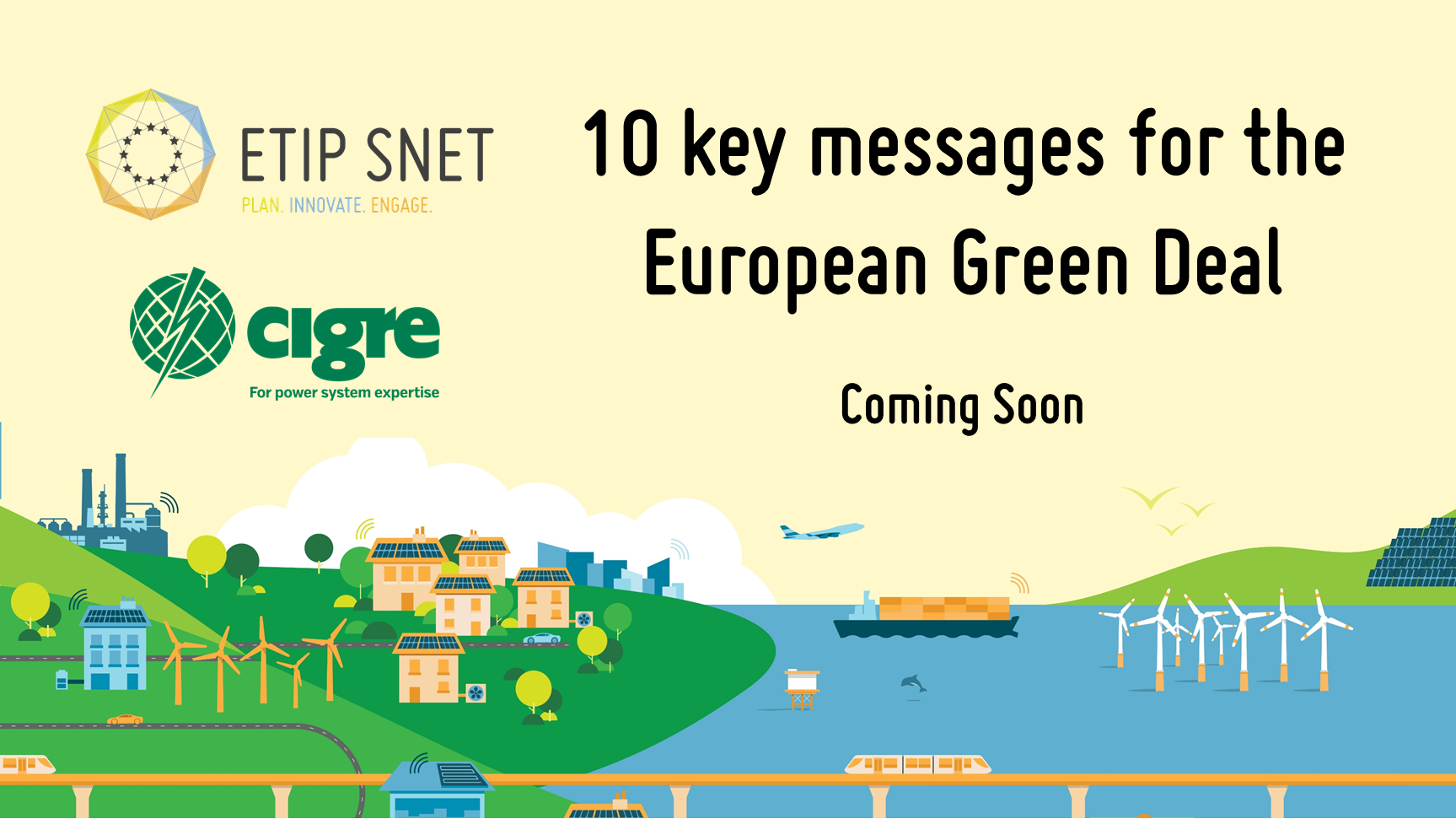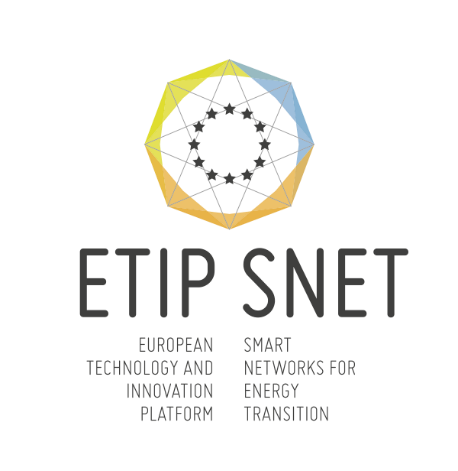THE EUROPEAN GREEN DEAL STARTS WITH THE ENERGY TRANSITION
 The European Technology and innovation Platform for Smart Networks in Energy Transition (ETIP SNET) and CIGRE strongly welcome the announcement of the European Green Deal by the European Commission - a document that outlines overarching policy priorities for the next five years, which are meant to help Europe reach carbon neutrality by 2050.
The European Technology and innovation Platform for Smart Networks in Energy Transition (ETIP SNET) and CIGRE strongly welcome the announcement of the European Green Deal by the European Commission - a document that outlines overarching policy priorities for the next five years, which are meant to help Europe reach carbon neutrality by 2050.
The European Green Deal is aligned with our 2050 ambitions for:
A low-carbon, secure, reliable, resilient, accessible, cost-efficient, and market-based pan-European integrated energy system supplying all of society and paving the way for a fully carbon-neutral circular economy by the year 2050, while maintaining and extending global industrial leadership in energy systems during the energy transition.
Hence, we would like to take this opportunity to highlight 10 key messages that illustrate a common Vision of the energy sector to be achieved by 2050, they are as follows:
1. In 2050, carbon-neutral and especially renewable energy alternatives to fossil fuels are implemented for all energy needs leading to a fully decarbonized energy system. Energy is produced by a variety of energy sources, both centralized and decentralized, fully or largely circular. The use of crude oil for all domestic, industrial and mobility needs is largely substituted with biomass and other renewable energy sources, e.g. CO2-free electricity for cars, trains, and urban buses and delivery trucks.
2. In 2050 and even before, citizens are fully empowered and as active consumers and prosumers, are engaged in local, regional and continental energy exchanges as well as peer-to-peer trading, for a wide choice of services and with energy prices at an economic optimum. Flexibility is offered largely by active grid users being generators, (active) consumers or prosumers, or aggregators, combined with controllable storage.
3. In 2050, energy storage plays a key role in energy transition by shifting of excess power from renewable generation in hydro reservoirs, clean gas storage, batteries or thermal storage. Flexible storage is also used by electricity grid operators for managing very short-term balancing needs including for nominal frequency, for handling grid congestion and respecting other system constraints, like voltage limits.
4. In 2050, Power to Gas (PtG) and Power to Heat (PtH) conversion technologies allow for efficient coupling of electricity, gas and heat networks, together with Gas-to-Power-and-Heat (GtP&H) and Gas-to-Heat (GtH). Make use of clean gas supply on the existing conventional pipelines systems. Moreover, Power to Liquid (PtL) technologies can supply the transport sector (heavy duty vehicles, large freights and airplanes) with low-carbon fuels (including different biofuels) and the industry with carbon-neutral inputs.
5. In 2050, the single pan-European wholesale electricity and gas markets are fully implemented to address dynamic market-time intervals, dynamic price zones and grid-constraints. Competitive and efficient retail markets empower citizens – which can be active consumers and prosumers – to control their self- and grid-supplied energy consumptions with the necessary framework (data protection and privacy, interoperable smart solutions). The investments in energy system technologies are market based and are catalysts for innovation and spill-over into other economic and technological sectors, thus contributing to the growth of the European economy.
6. In 2050, digitalisation is everywhere providing user-friendly services to all kinds of customers for planning, maintenance and operational issues, fostering information, analytics and connectivity. Several million households actively participate in real-time, automated demand response with connected appliances and equipment, while aggregation of smart charging technologies provides flexible electricity loads. Decentralised control techniques and peer-to-peer electricity trade permeates local energy communities and their interconnection to the electricity system. Shared platforms facilitate data exchange and decision-making in all parts of the integrated energy systems, thus enabling their advanced planning, operation, protection, control and automation.
7. In 2050, the heating and cooling of buildings is powered by renewable energy sources. Electricity is the main energy source for new buildings and to a large extent for refurbished buildings. Thanks to local energy generation and energy efficiency solutions, new buildings are nearly zero-energy and possibly positive-energy buildings supporting the real-time operations of the electricity as well as heating and cooling systems. In low-carbon district networks, heat is produced from heat pumps, biomass, biogas or Synthetic Natural Gas (SNG)-powered boilers, while waste heat recovery solutions are deployed for most buildings in the commercial and tertiary sectors.
8. In 2050, electricity system operation is based on highly automated optimisation of the grid, power generation and of all types of energy consumption. Electricity networks operate with very high penetration of power electronics and the associated monitoring and control equipment. They are dynamic and fully secured and coordinated at all voltage levels and they take advantage of RES and load diversity at continental or inter-continental level. The electricity system applies new protection solutions with associated cyber-secure, fast data communication and applies a full system monitoring and control approach to provide optimal solutions in terms of economic efficiency, system resilience, robustness and sustainable contributions.
9. In 2050, the European Energy System is operated as a System of Systems integrating all energy carriers, with the electricity system as the backbone. Coupling different energy networks occurs on all scales in the most cost-effective way (from integrated electricity, gas and heat infrastructures for buildings and mobility in cities with storage facilities, towards large-scale pan-European gas transmission and storage with conversion from and to electricity), as well as through new infrastructures for mobility (charging stations and refueling stations). Integrated energy systems, with the electricity systems in the center, ensure efficiency, reliability and resilience for pan-European, regional and local systems.
10. In 2050 the grids will be fully resilient to endure natural disasters (e.g. due to extreme weather events), physical attacks and cyber-attacks. Electricity is absolutely vital to society and the economies of all Europe. Critical restoration strategies will have been developed to withstand natural events, while advanced data analytics, AI and machine learning will provide early warnings to detect and prevent direct attacks.
While standards in digital architectures will have been well developed, disparate approaches to digital architectures will help in avoiding common failure modes. All technical and societal advances for energy will be resilient and secure for our future.

About ETIP SNET:
Since 2016, the key energy system players in Europe, represented through their EU associations, platforms and national stakeholders, started a strong and unique cooperation under the umbrella of ETIP SNET. With the support of hundreds of industry and research experts throughout Europe, it guides European R&I activities in the area of Smart Energy Networks. This covers areas such as energy systems management, storage and interface between power, gas, heat or transport networks, flexible generation, digitalisation of the energy systems, and energy customer involvement.
